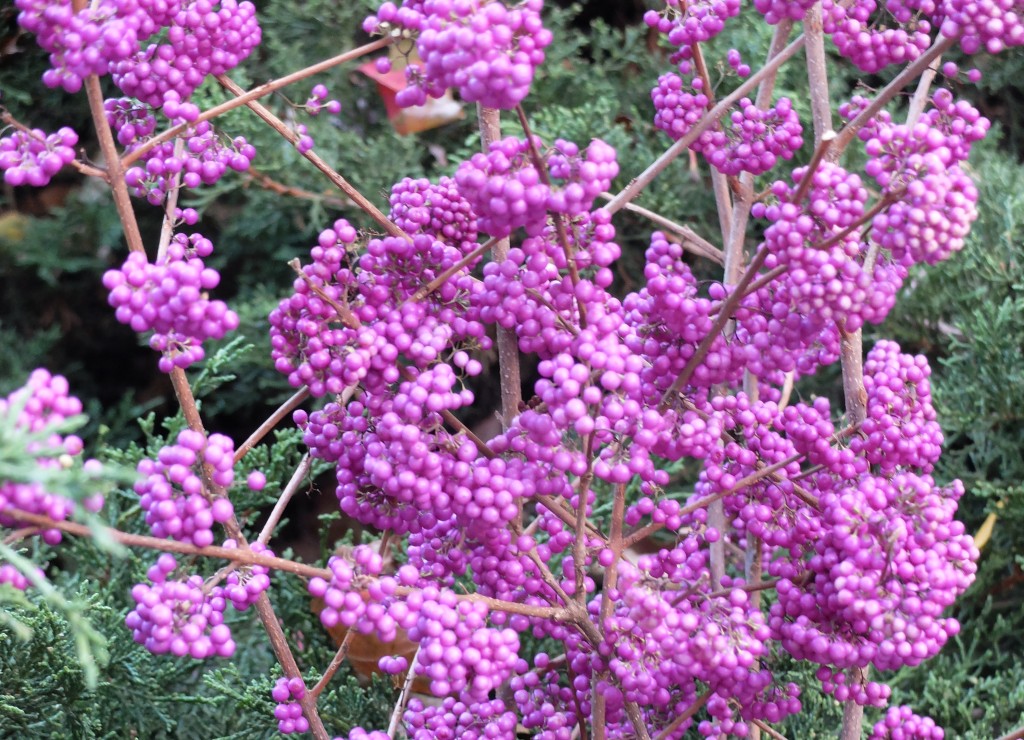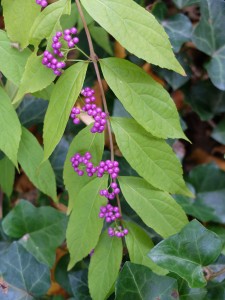Callicarpa

…brimming cornucopias which spill
fruits red and purple…
Elinor Wylie
 Our glorious autumn landscape includes an array of colorful fruits, which can be visually striking as well as providing food for birds and other wildlife. Dogwoods, crabapples, hollies, viburnums, hawthorns, and mountain ashes among others, provide bright red fruits. However, it is the beautyberry, Callicarpa sp. which can sometimes stop visitors in their tracks, due to their almost unimaginable, metallic-purple color. Etymologically Callicarpa has its roots in the Greek callos, meaning beauty, and carpos, meaning fruit. This is a large genus with 165 deciduous and evergreen species of shrubs and small trees worldwide, occurring in Asia, southeastern North America, South America, Madagascar, and Australia.
Our glorious autumn landscape includes an array of colorful fruits, which can be visually striking as well as providing food for birds and other wildlife. Dogwoods, crabapples, hollies, viburnums, hawthorns, and mountain ashes among others, provide bright red fruits. However, it is the beautyberry, Callicarpa sp. which can sometimes stop visitors in their tracks, due to their almost unimaginable, metallic-purple color. Etymologically Callicarpa has its roots in the Greek callos, meaning beauty, and carpos, meaning fruit. This is a large genus with 165 deciduous and evergreen species of shrubs and small trees worldwide, occurring in Asia, southeastern North America, South America, Madagascar, and Australia.
 Four-to-six-feet tall, and wide, beautyberries are generally indistinguishable for most of the year, often blending into a shrub border. The opposite, simple, two-to-five-inch long, pointed leaves may provide a faint yellow autumn color. In July small, pinkish-purple flowers occur close to the stem, often hidden under the leaves. It is in late autumn, when the leaves have fallen away that the ultimate beauty of its fruit is dramatically revealed. Birds have a tendency to leave quantities of this fruit for later, early winter food, so it is not uncommon to sometimes marvel at this bold purple fruit juxtaposed with white snow cover.
Four-to-six-feet tall, and wide, beautyberries are generally indistinguishable for most of the year, often blending into a shrub border. The opposite, simple, two-to-five-inch long, pointed leaves may provide a faint yellow autumn color. In July small, pinkish-purple flowers occur close to the stem, often hidden under the leaves. It is in late autumn, when the leaves have fallen away that the ultimate beauty of its fruit is dramatically revealed. Birds have a tendency to leave quantities of this fruit for later, early winter food, so it is not uncommon to sometimes marvel at this bold purple fruit juxtaposed with white snow cover.
Look for some of our beautiful beautyberries on Arethusa Path, Hummingbird Path, Halcyon Garden, and Lily Path.
~
Leave a Reply